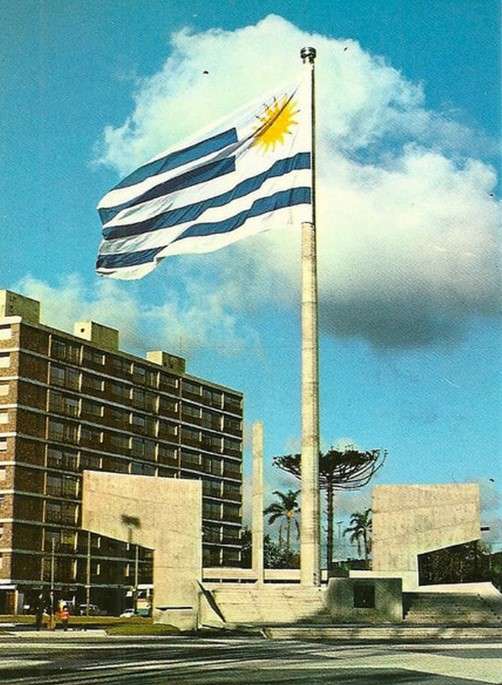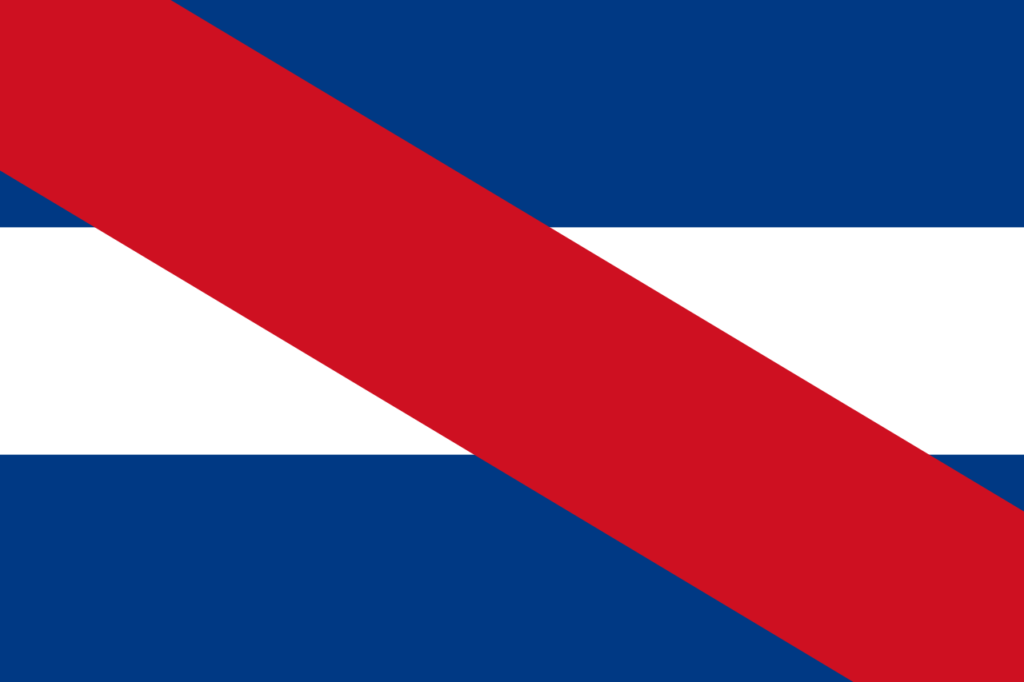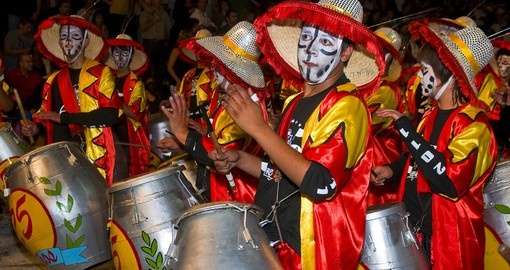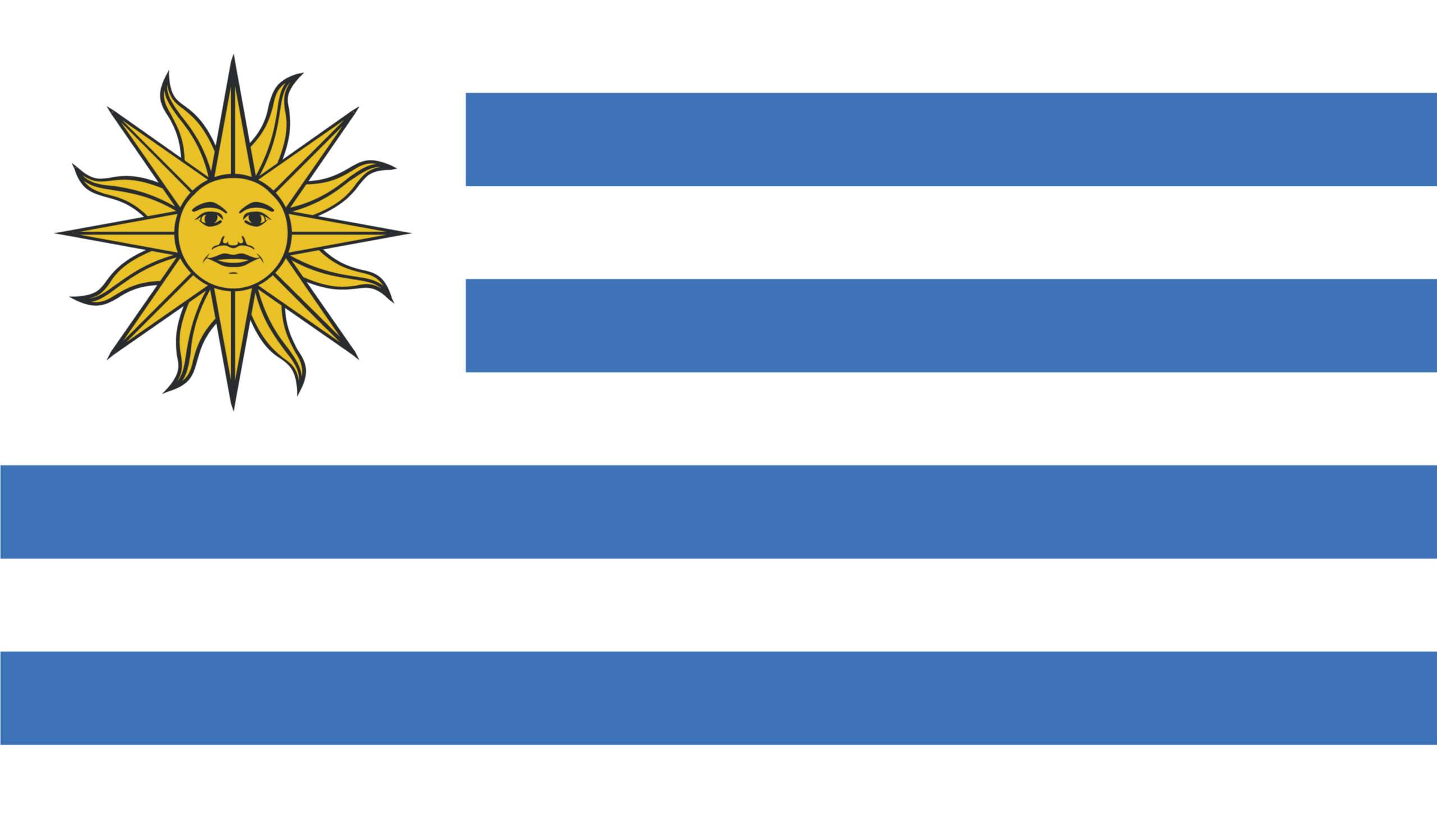
Uruguay is a nation situated on the southeast coast of South America. Despite being the second smallest country on the continent, it has a large amount of cultivable land compared to its population size and has a history and culture that is similar to that of its larger neighbouring countries, Brazil and Argentina.
Colours And Meaning
The flag of Uruguay is composed of five white and four blue horizontal stripes. A square with a white background is located in the upper left corner on top of the five horizontal stripes. Inside the square is the “May Sun” symbol, which is also used in Argentina as a symbol of freedom.
- The blue and white colours of the flag were inspired by the design of the Argentine flag.
- The number of horizontal stripes, which is nine, represents the nine provinces of Uruguay.
- The sun symbol on the flag contains 16 beams, unlike the sun of liberty on the Argentine flag which features 32 beams.
| NOTE: The design of the flag was created by Joaquín Suárez, the first head of Uruguay. |

Image Source: theculturetrip
Symbolism
The personified sun on the flag was inspired by Inti, the Incan God of the Sun. It is also referred to as the May Sun because on May 25, 1810, during the start of the process of gaining independence from Spain, the sun suddenly emerged from the clouds and rain.
It symbolizes independence, and its colour represents unity, truth, clarity, majesty, abundance, and richness. It is a symbol of freedom and goodness.
Amazing Facts About The Flag Of Uruguay
- The flag of Uruguay is one of the oldest flags in the world and it was officially adopted on July 11, 1830.
- When it was first introduced in 1828, it featured 17 stripes, but it was later revised to have nine stripes in 1830.
- The design of the current flag was initially influenced by the flags of Argentina and the United States following the declaration of independence. The original blue color was a lighter shade.
- As the number of provinces grew, so did the number of horizontal stripes on the flag. However, as the appearance of the flag with more stripes was not well received, the current flag design was officially adopted on July 11, 1830.
History Of Uruguay’s Flag
Its origins
The rule stated that the flag should feature nine light blue stripes arranged horizontally, representing the country’s divisions at the time, on a white background, with an empty area on the left side for a sun symbol.
But, in 1830 the number of light blue stripes was lowered to four, keeping the representation of nine divisions with four light blue and five white stripes.
In 1852, a further alteration was made where the sun should be portrayed as a golden circle with a face and 16 rays, eight of which are arranged as isosceles triangles, and the other eight as flames.
Connections to history or the past
Before achieving independence, Uruguay was a component of the Provincias Unidas del Río de la Plata, which is currently known as Argentina.
The colours used in the Uruguayan flag were borrowed from the Provincias Unidas’ flag. The design of elements on the flag was inspired by the flag of the United States, with its red and white stripes representing the 13 original colonies.
The emblem placed on the top-left corner of the flag, close to the flagpole, is a typical feature of flags.
In countries with Anglo-Saxon heritage, this component often includes the state’s crest and religious or political symbols. But, in other nations such as Uruguay, it serves as a representation of the historical ties to the former colonizer, in this case, it symbolizes the connection to the Provincias Unidas del Río de la Plata, which initiated the independence from Spain.
Three Official Flags
Uruguay has three official flags that are considered national symbols. These flags came into existence in the early 1810s and 1820s during the country’s fight for freedom, first from Spain and then from Brazil. In Uruguay, government buildings are mandated to hoist all three flags on national holidays.
In addition to the Uruguayan national flag, there are two other official flags in Uruguay, the Flag of Artigas and the Flag of the Thirty-Three. All these three flags are considered national symbols of Uruguay.
The National Flag of Uruguay
The national flag, officially known as el Pabellón Nacional, features four horizontal blue stripes on a white background. This flag design was created in 1828 by Joaquín Suárez (1781-1868), who later became the President of Uruguay.
The Flag of Artigas
The Flag of Artigas, officially known as la Bandera de Artigas, is a horizontal tricolour featuring blue-white-blue stripes, with a red diagonal stripe running from the upper inner to the lower outer corner of the flag.
The flag was created in 1815 by General José Gervasio Artigas, a national hero from Uruguay, who lived from 1764 to 1850. He advocated for a confederation of South American provinces, independent of Spain, and the red diagonal stripe represents federalism.

Image Source: Wikipedia
The blue-white-blue stripes were first used in 1812 by another national hero of Argentina, General Manuel Belgrano (1770-1820), currently, the national flag of Argentina is still a blue-white-blue horizontal tricolor with the Sun of May in the center.
The Flag of Artigas has a special connection to the Armed Forces of Uruguay, A cockade of the flag is used on the uniforms of military personnel, and a roundel with the flag is used by the Uruguayan Air Force on aircraft.
The Flag of the Thirty-Three
The Flag of the Treinta y Tres, officially known as la Bandera de Los Treinta y Tres Orientales, is a tricolor of blue-white-red. On the white stripe is the national motto of Uruguay, LIBERTAD O MUERTE, which means Freedom or Death.

Image Source: Wikipedia
This flag was adopted in 1825 by The Thirty-Three Orientals, a militant group that initiated La Cruzada Libertadora, the fight for independence from Brazilian rule in the Oriental Province, which is now modern-day Uruguay. In 1828, after eight years of being a Brazilian province, Uruguay’s independence was acknowledged.
Fast Facts about Uruguay
| Official Name | Oriental Republic of Uruguay |
| Form Of Government | Republic with two legislative houses (Senate), the House of Representatives |
| Head Of State And Government | President |
| Capital | Montevideo |
| Code | UY (URY) |
| Official Language | Spanish |
| Largest City | Puerto Maldonado |
| Currency | peso uruguayo (UYU) |
| Total Area (Sq Km) | 193,356 |
| Most Popular Sport | Football (Soccer) |
| Highest Point | Cerro Catedral (Uruguay) (514 m) |
| Uruguay’s National Flag | Pabellón Nacional |
| What is the flag of Uruguay known as in general terms? | The flag is called “The Sun and Stripes” |
- Uruguay is a country with a rich culture, advanced in the arts, and is known for its high standard of living and stability.
- The climate is mild. The average temperature ranges from 22 degrees Celsius in January and February to 10 degrees Celsius in July. The period of most rainfall is April and May.
- The cuisine of Uruguay has been influenced by various other countries, beef is widely consumed. Popular dishes include Pulpo and Tire de Asado.
- Uruguay is also known for its cheese.
Ethnic Groups of Uruguay

Image Source: Goway.com
Uruguayans are primarily of European descent, mostly descended from 19th and 20th-century immigrants from Spain and Italy and, to a lesser extent, from France and Britain.
Some early settlers also came from Argentina and Paraguay. There are few direct descendants of Uruguay’s indigenous peoples left today. The proportion of black people and those of mixed black and white ancestry is even smaller.
Spanish is spoken throughout Uruguay, however, in the border towns near Brazil such as Rivera, a mix of Portuguese and Spanish can be heard, often in a slang called portuñol, derived from the words “português” and “español”.
Resources and Power
Uruguay imports the majority of its fuel, industrial raw materials, transportation equipment, and machinery. This is because it lacks indigenous commercial sources of petroleum, natural gas, coal, or iron,
Although the country’s low, undulating terrain is not typically good for hydroelectric development, by the early 1980s, hydroelectric plants on the Uruguay and Negro rivers were operating at full capacity. They now contribute to one-seventh of the nation’s electricity. Thermal power plants powered by gas and oil produce the remaining energy.
The Economy and Government of Uruguay

Image Source: WorldAtlas.com
The government is governed by the 1966 constitution, as revised after the military dictatorship (1973–85). Amendments were made in 1996 which split national and municipal elections and made changes in the presidential election’s voting process.
The president and a group of Ministers called the Council of Ministers to hold the authority to make executive decisions.
The vice president serves as the leader of the two-chambered legislative body. Both the president and vice president are elected for five years and are not allowed to run for the position again immediately after their term ends. If no presidential candidate receives the majority of votes, a second round of voting is held between the two leading contenders.
The General Assembly, which is made up of 31 Senators and 99 Representatives, is elected by the people for five-year terms.
By: Richa Singh



